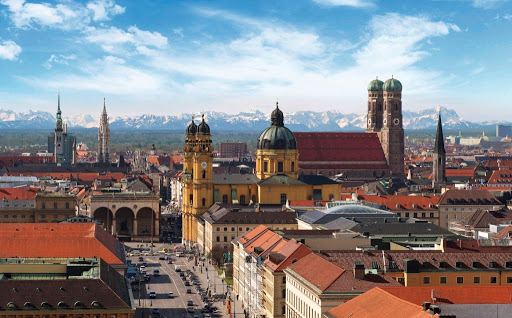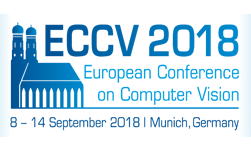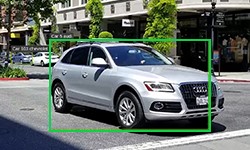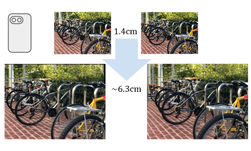NVIDIA Researchers will present 17 accepted papers and posters, one of them an oral, at the biennial European Conference on Computer Vision (ECCV) on September 8-14 in Munich, Germany.

Orals
ContextVP: Fully Context-Aware Video Prediction
Wonmin Byeon, Qin Wang, Rupesh Kumar Srivastava, and Petros Koumoutsakos
September 13, 02:45 PM
Abstract: Video prediction models based on convolutional networks, recurrent networks, and their combinations often result in blurry predictions. We identify an important contributing factor for imprecise predictions that has not been studied adequately in the literature: blind spots, i.e., lack of access to all relevant past information for accurately predicting the future. To address this issue, we introduce a fully context-aware architecture that captures the entire available past context for each pixel using Parallel MultiDimensional LSTM units and aggregates it using blending units. Our model outperforms a strong baseline network of 20 recurrent convolutional layers and yields state-ofthe-art performance for next step prediction. Moreover, it does so with fewer parameters than several recently proposed models, and does not rely on deep convolutional networks, multi-scale architectures, separation of background and foreground modeling, motion flow learning, or adversarial training. These results highlight that full awareness of past context is of crucial importance for video prediction.
Posters
Separating Reflection and Transmission Images in the Wild
Patrick Wieschollek (University of Tübingen), Orazio Gallo, Jinwei Gu, Jan Kautz
Abstract: The reflections caused by common semi-reflectors, such as glass windows, can impact the performance of computer vision algorithms. State-of-the-art methods can remove reflections on synthetic data and in controlled scenarios. However, they are based on strong assumptions and do not generalize well to real-world images. Contrary to a common misconception, real-world images are challenging even when polarization information is used. We present a deep learning approach to separate the reflected and the transmitted components of the recorded irradiance, which explicitly uses the polarization properties of light. To train it, we introduce an accurate synthetic data generation pipeline, which simulates realistic reflections, including those generated by curved and non-ideal surfaces, non-static scenes, and high-dynamic-range scenes.
Hand Pose Estimation via Latent 2.5D Heatmap Regression
Umar Iqbal, Pavlo Molchanov, Thomas Breuel, Juergen Gall, Jan Kautz
Abstract: Estimating the 3D pose of a hand is an essential part of human-computer interaction. Estimating 3D pose using depth or multi-view sensors has become easier with recent advances in computer vision, however, regressing pose from a single RGB image is much less straightforward. The main difficulty arises from the fact that 3D pose requires some form of depth estimates, which are ambiguous given only an RGB image. In this paper we propose a new method for 3D hand pose estimation from a monocular image through a novel 2.5D pose representation. Our new representation estimates pose up to a scaling factor, which can be estimated additionally if a prior of the hand size is given. We implicitly learn depth maps and heatmap distributions with a novel CNN architecture. Our system achieves the state-of-the-art estimation of 2D and 3D hand pose on several challenging datasets in presence of severe occlusions.
Unsupervised Image-to-Image Translation Networks
Ming-Yu Liu, Thomas Breuel, Jan Kautz
Abstract: Unsupervised image-to-image translation aims at learning a joint distribution of images in different domains by using images from the marginal distributions in individual domains. Since there exists an infinite set of joint distributions that can arrive the given marginal distributions, one could infer nothing about the joint distribution from the marginal distributions without additional assumptions. To address the problem, we make a shared-latent space assumption and propose an unsupervised image-to-image translation framework based on Coupled GANs. We compare the proposed framework with competing approaches and present high quality image translation results on various challenging unsupervised image translation tasks, including street scene image translation, animal image translation, and face image translation. We also apply the proposed framework to domain adaptation and achieve state-of-the-art performance on benchmark datasets. Code and additional results are available in this https URL .
Switchable Temporal Propagation Network
Sifei Liu, Guangyu Zhong, Shalini De Mello, Jinwei Gu, Varun Jampani, Ming-Hsuan Yang, Jan Kautz
Abstract: Videos contain highly redundant information between frames. Such redundancy has been extensively studied in video compression and encoding, but is less explored for more advanced video processing. In this paper, we propose a learnable unified framework for propagating a variety of visual properties of video images, including but not limited to color, high dynamic range (HDR), and segmentation information, where the properties are available for only a few key-frames. Our approach is based on a temporal propagation network (TPN), which models the transition-related affinity between a pair of frames in a purely data-driven manner. We theoretically prove two essential factors for TPN: (a) by regularizing the global transformation matrix as orthogonal, the “style energy” of the property can be well preserved during propagation; (b) such regularization can be achieved by the proposed switchable TPN with bi-directional training on pairs of frames. We apply the switchable TPN to three tasks: colorizing a grayscale video based on a few color keyframes, generating an HDR video from a low dynamic range (LDR) video and a few HDR frames, and propagating a segmentation mask from the first frame in videos. Experimental results show that our approach is significantly more accurate and efficient than the state-of-the-art methods.
Tackling 3D ToF Artifacts Through Learning and the FLAT Dataset
Qi Guo (SEAS, Harvard University), Iuri Frosio, Orazio Gallo, Todd Zickler (SEAS, Harvard University), Jan Kautz
Abstract: Scene motion, multiple reflections, and sensor noise introduce artifacts in the depth reconstruction performed by time-of-flight cameras. We propose a two-stage, deep-learning approach to address all of these sources of artifacts simultaneously. We also introduce FLAT, a synthetic dataset of 2000 ToF measurements that capture all of these non idealities, and can be used to simulate different hardware. Using the Kinect camera as a baseline, we show improved reconstruction errors on simulated and real data, as compared with state-of-the-art methods.
Simultaneous Edge Alignment and Learning
Zhiding Yu, Weiyang Liu, Yang Zou, Chen Feng, Srikumar Ramalingam, B. V. K. Vijaya Kumar, and Jan Kautz
Abstract: Edge detection is among the most fundamental vision problems for its role in perceptual grouping and its wide applications. Recent advances in representation learning have led to considerable improvements in this area. Many state of the art edge detection models are learned with fully convolutional networks (FCNs). However, FCN-based edge learning tends to be vulnerable to misaligned labels due to the delicate structure of edges. While such problem was considered in evaluation benchmarks, similar issue has not been explicitly addressed in general edge learning. In this paper, we show that label misalignment can cause considerably degraded edge learning quality, and address this issue by proposing a simultaneous edge alignment and learning framework. To this end, we formulate a probabilistic model where edge alignment is treated as latent variable optimization, and is learned end-to-end during network training. Experiments show several applications of this work, including improved edge detection with state of the art performance, and automatic refinement of noisy annotations.
Superpixel Sampling Networks
Varun Jampani, Deqing Sun, Ming-Yu Liu, Ming-Hsuan Yang, Jan Kautz
Abstract: Superpixels provide an efficient low/mid-level representation of image data, which greatly reduces the number of image primitives for subsequent vision tasks. Existing superpixel algorithms are not differentiable, making them difficult to integrate into otherwise end-to-end trainable deep neural networks. We develop a new differentiable model for superpixel sampling that leverages deep networks for learning superpixel segmentation. The resulting “Superpixel Sampling Network” (SSN) is end-to-end trainable, which allows learning task-specific superpixels with flexible loss functions and has fast runtime. Extensive experimental analysis indicates that SSNs not only outperform existing superpixel algorithms on traditional segmentation benchmarks, but can also learn superpixels for other tasks. In addition, SSNs can be easily integrated into downstream deep networks resulting in performance improvements.
A Closed-form Solution to Photorealistic Image Stylization
Yijun Li, Ming-Yu Liu, Xueting Li, Ming-Hsuan Yang, Jan Kautz
Abstract: Photorealistic image stylization concerns transferring style of a reference photo to a content photo with the constraint that the stylized photo should remain photorealistic. While several photorealistic image stylization methods exist, they tend to generate spatially inconsistent stylizations with noticeable artifacts. In this paper, we propose a method to address these issues. The proposed method consists of a stylization step and a smoothing step. While the stylization step transfers the style of the reference photo to the content photo, the smoothing step ensures spatially consistent stylizations. Each of the steps has a closed-form solution and can be computed efficiently. We conduct extensive experimental validations. The results show that the proposed method generates photorealistic stylization outputs that are more preferred by human subjects as compared to those by the competing methods while running much faster. Source code and additional results are available at this https URL.
Learning Rigidity in Dynamic Scenes with a Moving Camera for 3D Motion Field Estimation
Zhaoyang Lv, Kihwan Kim, Alejandro Troccoli, Deqing Sun, James M. Rehg, Jan Kautz
Abstract: Estimation of 3D motion in a dynamic scene from a temporal pair of images is a core task in many scene understanding problems. In real world applications, a dynamic scene is commonly captured by a moving camera (i.e., panning, tilting or hand-held), increasing the task complexity because the scene is observed from different view points. The main challenge is the disambiguation of the camera motion from scene motion, which becomes more difficult as the amount of rigidity observed decreases, even with successful estimation of 2D image correspondences. Compared to other state-of-the-art 3D scene flow estimation methods, in this paper we propose to learn the rigidity of a scene in a supervised manner from a large collection of dynamic scene data, and directly infer a rigidity mask from two sequential images with depths. With the learned network, we show how we can effectively estimate camera motion and projected scene flow using computed 2D optical flow and the inferred rigidity mask. For training and testing the rigidity network, we also provide a new semi-synthetic dynamic scene dataset (synthetic foreground objects with a real background) and an evaluation split that accounts for the percentage of observed non-rigid pixels. Through our evaluation we show the proposed framework outperforms current state-of-the-art scene flow estimation methods in challenging dynamic scenes.
Fast and Accurate Point Cloud Registration using Trees of Gaussian Mixtures
Ben Eckart, Kihwan Kim, Jan Kautz
Abstract: Point cloud registration sits at the core of many important and challenging 3D perception problems including autonomous navigation, SLAM, object/scene recognition, and augmented reality. In this paper, we present a new registration algorithm that is able to achieve state-of-the-art speed and accuracy through its use of a hierarchical Gaussian Mixture Model (GMM) representation. Our method constructs a top-down multi-scale representation of point cloud data by recursively running many small-scale data likelihood segmentations in parallel on a GPU. We leverage the resulting representation using a novel PCA-based optimization criterion that adaptively finds the best scale to perform data association between spatial subsets of point cloud data. Compared to previous Iterative Closest Point and GMM-based techniques, our tree-based point association algorithm performs data association in logarithmic-time while dynamically adjusting the level of detail to best match the complexity and spatial distribution characteristics of local scene geometry. In addition, unlike other GMM methods that restrict covariances to be isotropic, our new PCA-based optimization criterion well-approximates the true MLE solution even when fully anisotropic Gaussian covariances are used. Efficient data association, multi-scale adaptability, and a robust MLE approximation produce an algorithm that is up to an order of magnitude both faster and more accurate than current state-of-the-art on a wide variety of 3D datasets captured from LiDAR to structured light.
Rendering Portraitures from Monocular Camera and Beyond
Xiangyu Xu, Deqing Sun, Sifei Liu, Wenqi Ren, Yujin Zhang, Ming-Hsuan Yang, and Jian Sun
Abstract: Shallow Depth-of-Field (DoF) is a desirable effect in photography which renders artistic photos. Usually, it requires single-lens reflex cameras and certain photography skills to generate such effects. Recently, dual-lens on cellphones is used to estimate scene depth and simulate DoF effects for portrait shots. However, this technique cannot be applied to photos already taken and does not work well for wholebody scenes where the subject is at a distance from the cameras. In this work, we introduce an automatic system that achieves portrait DoF rendering for monocular cameras. Specifically, we first exploit Convolutional Neural Networks to estimate the relative depth and portrait segmentation maps from a single input image. Since these initial estimates from a single input are usually coarse and lack fine details, we further learn pixel affinities to refine the coarse estimation maps. With the refined estimation, we conduct depth and segmentation-aware blur rendering to the input image with a Conditional Random Field and image matting. In addition, we train a spatially-variant Recursive Neural Network to learn and accelerate this rendering process. We show that the proposed algorithm can effectively generate portraitures with realistic DoF effects using one single input. Experimental results also demonstrate that our depth and segmentation estimation modules perform favorably against the state-of-the-art methods both quantitatively and qualitatively.
Learning Data Terms for Image Deblurring
Jiangxin Dong, Jinshan Pan, Deqing Sun, Zhixun Su, and Ming-Hsuan Yang
Abstract: Existing deblurring methods mainly focus on developing effective image priors and assume that blurred images contain insignificant amounts of noise. However, state-of-the-art deblurring methods do not perform well on real-world images degraded with significant noise or outliers. To address these issues, we show that it is critical to learn data fitting terms beyond the commonly used 1 or2 norm. We propose a simple and effective discriminative framework to learn data terms that can adaptively handle blurred images in the presence of severe noise and outliers. Instead of learning the distribution of the data fitting errors, we directly learn the associated shrinkage function for the data term using a cascaded architecture, which is more flexible and efficient. Our analysis shows that the shrinkage functions learned at the intermediate stages can effectively suppress noise and preserve image structures. Extensive experimental results show that the proposed algorithm performs favorably against state-of-the-art methods.
Unsupervised Domain Adaptation for Semantic Segmentation via Class-Balanced Self-Training
Yang Zou, Zhiding Yu; B. V. K. Vijaya Kumar, USA; Jinsong Wang, General Motors
Abstract: Recent deep networks achieved state of the art performance on a variety of semantic segmentation tasks. Despite such progress, these models often face challenges in real world “wild tasks” where large difference between labeled training/source data and unseen test/target data exists. In particular, such difference is often referred to as “domain gap”,and could cause significantly decreased performance which cannot be easily remedied by further increasing the representation power. Unsupervised domain adaptation (UDA) seeks to overcome such problem without target domain labels. In this paper, we propose a novel UDA framework based on an iterative self-training (ST) procedure, where the problem is formulated as latent variable loss minimization, and can be solved by alternatively generating pseudo labels on target data and re-training the model with these labels. On top of ST, we also propose a novel class-balanced self-training (CBST) framework to avoid the gradual dominance of large classes on pseudo-label generation, and introduce spatial priors to refine generated labels. Comprehensive experiments show that the proposed methods achieve state of the art semantic segmentation performance under multiple major UDA settings.
SDC-Net: Video prediction using spatially-displaced convolution
Fitsum A. Reda, Guilin Liu, Kevin J. Shih, Robert Kirby, Jon Barker, David Tarjan, Andrew Tao, Bryan Catanzaro
Abstract: We present an approach for high-resolution video frame prediction by conditioning on both past frames and past optical flows. Previous approaches rely on resampling past frames, guided by a learned future optical flow, or on direct generation of pixels. Resampling based on flow is insufficient because it cannot deal with disocclusions. Generative models currently lead to blurry results. Recent approaches synthesis a pixel by convolving input patches with a predicted kernel. However, their memory requirement increases with kernel size. Here, we present spatially-displaced convolution (SDC) module for video frame prediction. We learn a motion vector and a kernel for each pixel and synthesize a pixel by applying the kernel at a displaced location in the source image, defined by the predicted motion vector. Our approach inherits the merits of both vector-based and kernel-based approaches, while ameliorating their respective disadvantages. We train our model on 428K unlabelled 1080p video game frames. Our approach produces state-of-the-art results, achieving an SSIM score of 0.904 on high-definition YouTube-8M videos, 0.918 on Caltech Pedestrian videos. Our model handles large motion effectively and synthesizes crisp frames with consistent motion.
Image Inpainting for Irregular Holes Using Partial Convolutions
Guilin Liu, Fitsum A. Reda, Kevin J. Shih, Ting-Chun Wang, Andrew Tao, Bryan Catanzaro
Abstract: Existing deep learning based image inpainting methods use a standard convolutional network over the corrupted image, using convolutional filter responses conditioned on both valid pixels as well as the substitute values in the masked holes (typically the mean value). This often leads to artifacts such as color discrepancy and blurriness. Postprocessing is usually used to reduce such artifacts, but are expensive and may fail. We propose the use of partial convolutions, where the convolution is masked and renormalized to be conditioned on only valid pixels. We further include a mechanism to automatically generate an updated mask for the next layer as part of the forward pass. Our model outperforms other methods for irregular masks. We show qualitative and quantitative comparisons with other methods to validate our approach.
DeepIM: Deep Iterative Matching for 6D Pose Estimation
Yi Li, Gu Wang, Xiangyang Ji, Yu Xiang, Dieter Fox
Abstract: Estimating the 6D pose of objects from images is an important problem in various applications such as robot manipulation and virtual reality. While direct regression of images to object poses has limited accuracy, matching rendered images of an object against the input image can produce accurate results. In this work, we propose a novel deep neural network for 6D pose matching named DeepIM. Given an initial pose estimation, our network is able to iteratively refine the pose by matching the rendered image against the observed image. The network is trained to predict a relative pose transformation using an untangled representation of 3D location and 3D orientation and an iterative training process. Experiments on two commonly used benchmarks for 6D pose estimation demonstrate that DeepIM achieves large improvements over state-of-the-art methods. We furthermore show that DeepIM is able to match previously unseen objects.










